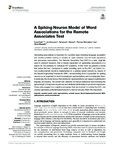A Spiking Neuron Model of Word Associations for the Remote Associates Test
| dc.contributor.author | Kajić, I | |
| dc.contributor.author | Gosmann, J | |
| dc.contributor.author | Stewart, TC | |
| dc.contributor.author | Wennekers, Thomas | |
| dc.contributor.author | Eliasmith, C | |
| dc.date.accessioned | 2017-02-13T15:03:02Z | |
| dc.date.accessioned | 2017-08-03T11:36:27Z | |
| dc.date.available | 2017-02-13T15:03:02Z | |
| dc.date.available | 2017-08-03T11:36:27Z | |
| dc.date.issued | 2017-02-02 | |
| dc.identifier.issn | 1664-1078 | |
| dc.identifier.issn | 1664-1078 | |
| dc.identifier.other | ARTN 99 | |
| dc.identifier.uri | http://hdl.handle.net/10026.1/9663 | |
| dc.description.abstract |
Generating associations is important for cognitive tasks including language acquisition and creative problem solving. It remains an open question how the brain represents and processes associations. The Remote Associates Test (RAT) is a task, originally used in creativity research, that is heavily dependent on generating associations in a search for the solutions to individual RAT problems. In this work we present a model that solves the test. Compared to earlier modeling work on the RAT, our hybrid (i.e., non-developmental) model is implemented in a spiking neural network by means of the Neural Engineering Framework (NEF), demonstrating that it is possible for spiking neurons to be organized to store the employed representations and to manipulate them. In particular, the model shows that distributed representations can support sophisticated linguistic processing. The model was validated on human behavioral data including the typical length of response sequences and similarity relationships in produced responses. These data suggest two cognitive processes that are involved in solving the RAT: one process generates potential responses and a second process filters the responses. | |
| dc.format.extent | 99- | |
| dc.format.medium | Electronic-eCollection | |
| dc.language | eng | |
| dc.language.iso | en | |
| dc.publisher | Frontiers Media SA | |
| dc.relation.replaces | http://hdl.handle.net/10026.1/8461 | |
| dc.relation.replaces | 10026.1/8461 | |
| dc.subject | semantic search | |
| dc.subject | vector representations | |
| dc.subject | semantic spaces | |
| dc.subject | neural engineering framework(NEF) | |
| dc.subject | spiking neurone | |
| dc.subject | remote associates test | |
| dc.title | A Spiking Neuron Model of Word Associations for the Remote Associates Test | |
| dc.type | journal-article | |
| dc.type | Journal Article | |
| plymouth.author-url | https://www.webofscience.com/api/gateway?GWVersion=2&SrcApp=PARTNER_APP&SrcAuth=LinksAMR&KeyUT=WOS:000393223700001&DestLinkType=FullRecord&DestApp=ALL_WOS&UsrCustomerID=11bb513d99f797142bcfeffcc58ea008 | |
| plymouth.issue | FEB | |
| plymouth.volume | 8 | |
| plymouth.publication-status | Published | |
| plymouth.journal | Frontiers in Psychology | |
| dc.identifier.doi | 10.3389/fpsyg.2017.00099 | |
| plymouth.organisational-group | /Plymouth | |
| plymouth.organisational-group | /Plymouth/Admin Group - REF | |
| plymouth.organisational-group | /Plymouth/Admin Group - REF/REF Admin Group - FoSE | |
| plymouth.organisational-group | /Plymouth/Faculty of Science and Engineering | |
| plymouth.organisational-group | /Plymouth/Faculty of Science and Engineering/School of Engineering, Computing and Mathematics | |
| plymouth.organisational-group | /Plymouth/REF 2021 Researchers by UoA | |
| plymouth.organisational-group | /Plymouth/REF 2021 Researchers by UoA/UoA11 Computer Science and Informatics | |
| plymouth.organisational-group | /Plymouth/Users by role | |
| plymouth.organisational-group | /Plymouth/Users by role/Academics | |
| dc.publisher.place | Switzerland | |
| dcterms.dateAccepted | 2017-01-16 | |
| dc.identifier.eissn | 1664-1078 | |
| dc.rights.embargoperiod | No embargo | |
| rioxxterms.versionofrecord | 10.3389/fpsyg.2017.00099 | |
| rioxxterms.licenseref.uri | http://www.rioxx.net/licenses/all-rights-reserved | |
| rioxxterms.licenseref.startdate | 2017-02-02 | |
| rioxxterms.type | Journal Article/Review | |
| plymouth.oa-location | http://journal.frontiersin.org/article/10.3389/fpsyg.2017.00099/full |


